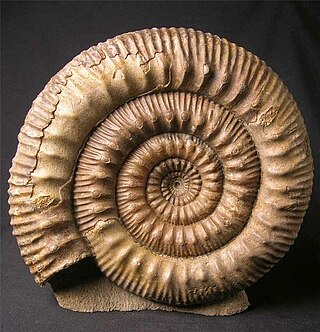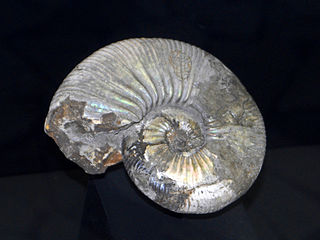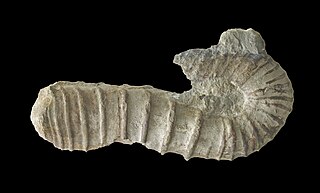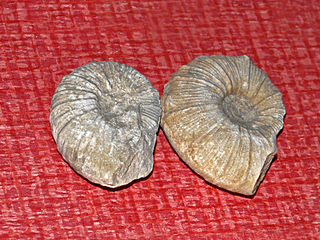
Euhoplites is an extinct ammonoid cephalopod from the Lower Cretaceous, characterized by strongly ribbed, more or less evolute, compressed to inflated shells with flat or concave ribs, typically with a deep narrow groove running down the middle. In some, ribs seem to zigzag between umbilical tubercles and parallel ventrolateral clavi. In others the ribs are flexuous and curve forward from the umbilical shoulder and lap onto either side of the venter.

Stephanoceras is an extinct genus of Stephanoceratoid ammonite which lived during the Bajocian. It is the type genus of the family Stephanoceratidae.

Acanthohoplites is an extinct genus of ammonites in the family Parahoplitidae that lived in the Aptian and Early Albian stages of the Early Cretaceous.
Aioloceras is an ammonite, order Ammonitida, from near the end of the Early Cretaceous. The shell is compressed with the outer whorl covering much of the previous. Sides are slightly convex, converge toward a narrowly ached venter. Inner whorls have sharp falcoid ribs, outer are smooth. Umbilical tubercles are lacking. Similar related forms include Neosaynella and Cleoniceras.

Aulacostephanus is an extinct ammonoid cephalopod genus from the Upper Jurassic Tithonian belonging to the perisphinctoidean family Aulacostephanidae.

Astieridiscus is an extinct lower Cretaceous ammonite. Its shell evolute, covered by dense, simple or branching, slightly flexuous ribs. The sides are slightly flattened, the venter rounded. No umbilical or other tubercles except on innermost whorl. Superficially resembles Olcostephanus.

Puzosia (Bhimaites) is a subgenus of desmoceratid ammonites with a subinvolute, mostly smooth, high whorled shell with convex or flat sides and frequent constrictions on the venter. It is included in the subfamily Puzosiinae and has been found in Upper Albian and Cenomanian sediments in Angola, South Africa, and southern India.
Anisoceratidae is an extinct family of heteromorph ammonites which belong to the Ancyloceratina superfamily Turrilitoidea. Members of the family range is from the lower Albian to the upper Turonian. The family is possibly derived from a member of the Hamitidae.

Normannites is a strongly ribbed evolute Middle Jurassic genus of ammonite included in the stephanoceratoid family Stephanoceratidae.

Peltoceras is an extinct ammonite genus from the aspidoceratid subfamily Peltoceratinae that lived during the later part of the Middle Jurassic.
Pleurohoplites is a genus in the ammonitid family Hoplitidae, found in middle Cretaceous of Europe, and included in the subfamily Hoplitinae.
Brancoceras is a rather small, strongly ribbed, acanthoceratacean ammonite from the Albian stage of the Lower Cretaceous, the shell evolute with a subquadrate whorl section and rounded venter. The suture forms a finely squiggly line with well-defined lobes and saddles. Brancoceras (Eubrancoceras) aegoceratoides reached a diameter of at least 4.2 centimetres (1.7 in).
Brancoceratidae is a family of acanthoceratoid ammonites from the middle of the Cretaceous, recognized by their commonly evolute shells with round, oval, or quadrate whorls, strong ribs, usual ventral keels, and at least, umblical tubercles. The family is thought to be derived from the Desmoceratidae (Desmoceratoidea), perhaps from Silesitoides or some allied genus.

Hypophylloceras is a Cretaceous ammonite with a finely ribbed, compressed, involute shell; some having periodic stronger ribs or folds. The suture is complex, with large, asymmetric and finely divided lobes; the 1st lateral being much larger than the external (=ventral) and 2nd lateral lobes. Saddle endings commonly not phylloid.

Neocomites is a genus of ammonite from the Lower Cretaceous, Berriasian to Hauterivian, and type genus for the Neocomitidae.
Leymeriellidae is an extinct family of Lower Cretaceous ammonites comprising rather small forms distinguished from Hoplitidae by their flattened and grooved ribs and virtual absence of umbilical tubercles. The family is derived from the Desmoceratidae. Leymeriella schrammeni anterior has evolved from Desmoceras keilhacki keilhacki.
Pseudohaploceras is a genus of desmosceratid ammonites from the Early Cretaceous; Valanginian to Albian epochs.
Melchiorites is a desmoceratid ammonite genus included in the subfamily Puzosiinae. Member species are characterized by an essentially evolute shell in which the early whorls are smooth, with sinuous radial or oblique constrictions but in which later whorls have feeble intermediate ribs on the outer part of the sides and venter.

Hamulina is an extinct ammonoid cephalopod genus belonging to the family Hamulinidae. These cephalopod were fast-moving nektonic carnivores. They lived during the Cretaceous period, Barremian age. The type species is Hamulina astieriana.

Holcodiscus is an extinct ammonite genus placed in the family Holcodiscidae. Species in this genus were fast-moving nektonic carnivores. The type species of the genus is Ammonites caillaudianus.












